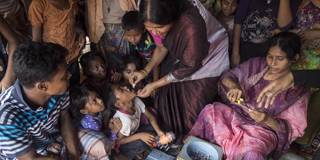In recent years, the world has made considerable progress in the fight against cholera. But, with climate change, urbanization, and population growth creating an ideal breeding ground for the disease, stronger action is urgently needed to bring eradication within reach.
JOHANNESBURG – Beginning in 2017, Yemen suffered the largest and fastest-spreading cholera outbreak in modern history. Thousands of new cases were reported daily, more than half of them children. And Yemen was not alone: that year, more than 1.2 million people contracted cholera in 34 countries, and 5,654 died. Given that cholera is preventable and treatable, this never should have happened. Fortunately, there is reason to hope that it won’t happen again.
Cholera is a diarrheal disease caused by consuming water or food contaminated by the bacterium Vibrio cholerae. It spreads rapidly in areas where sewage and drinking water supplies are inadequately treated, making it largely a disease of the poorest and most vulnerable – the very young, the very old, the malnourished. and the displaced. Without treatment, cholera can kill within hours. Though the treatment – basic rehydration therapy – is simple, society’s most marginalized members are unlikely to have access to it.
But for the last three years, the Global Task Force on Cholera Control – a partnership of over 50 organizations – has been working to eliminate cholera as a public health threat. As chair of the GTFCC, I proudly support our global roadmap, which aims to eradicate the disease in 20 countries and achieve a 90% reduction in associated deaths by 2030, both by expanding the use of the oral cholera vaccine and by improving water, sanitation, and hygiene (WASH) services.

JOHANNESBURG – Beginning in 2017, Yemen suffered the largest and fastest-spreading cholera outbreak in modern history. Thousands of new cases were reported daily, more than half of them children. And Yemen was not alone: that year, more than 1.2 million people contracted cholera in 34 countries, and 5,654 died. Given that cholera is preventable and treatable, this never should have happened. Fortunately, there is reason to hope that it won’t happen again.
Cholera is a diarrheal disease caused by consuming water or food contaminated by the bacterium Vibrio cholerae. It spreads rapidly in areas where sewage and drinking water supplies are inadequately treated, making it largely a disease of the poorest and most vulnerable – the very young, the very old, the malnourished. and the displaced. Without treatment, cholera can kill within hours. Though the treatment – basic rehydration therapy – is simple, society’s most marginalized members are unlikely to have access to it.
But for the last three years, the Global Task Force on Cholera Control – a partnership of over 50 organizations – has been working to eliminate cholera as a public health threat. As chair of the GTFCC, I proudly support our global roadmap, which aims to eradicate the disease in 20 countries and achieve a 90% reduction in associated deaths by 2030, both by expanding the use of the oral cholera vaccine and by improving water, sanitation, and hygiene (WASH) services.